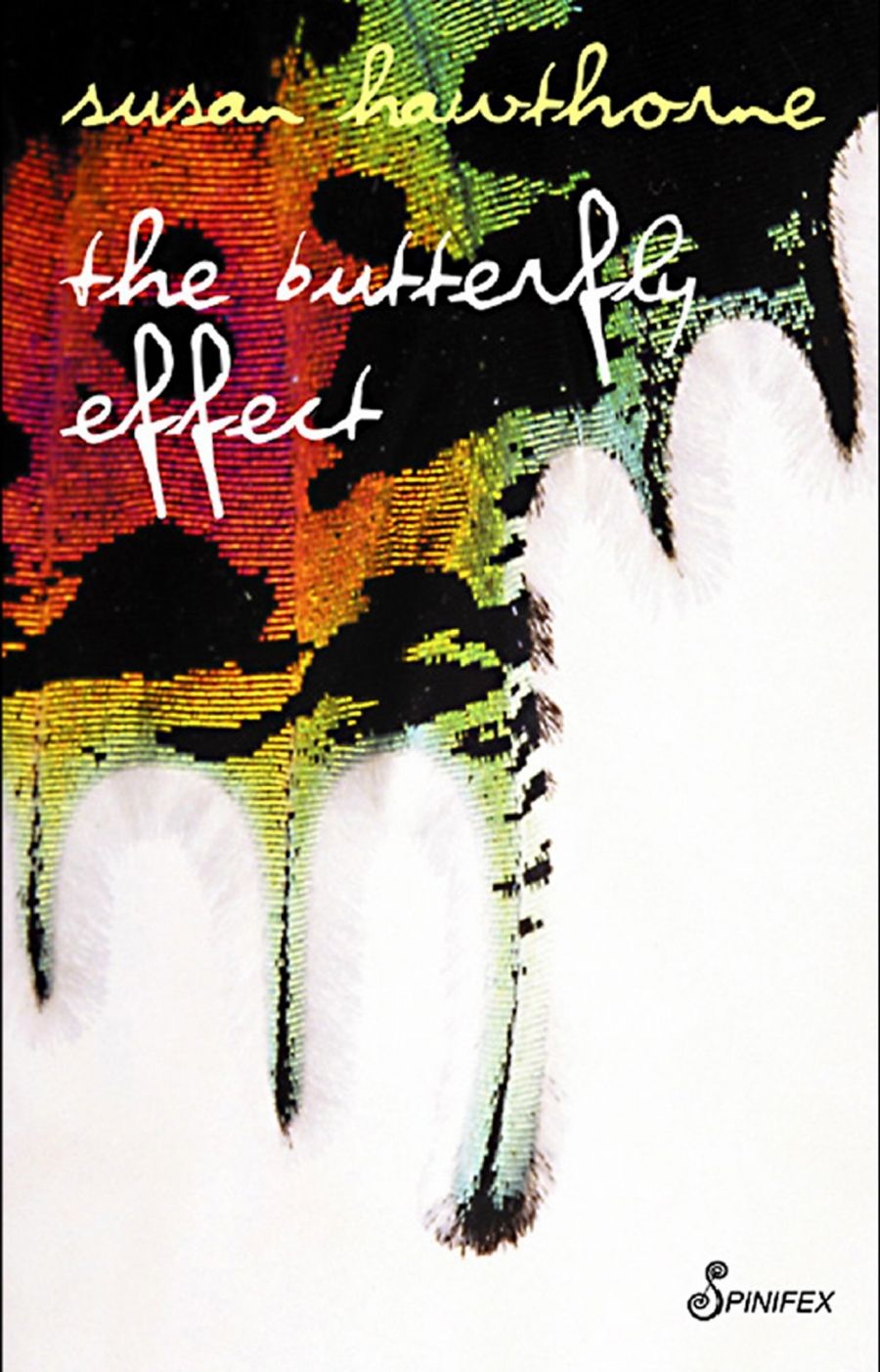
- Free Article: No
- Contents Category: Poetry
- Review Article: Yes
- Online Only: No
- Custom Highlight Text:
The Butterfly Effect is a travel guide to the inner sanctum of lesbian sensibility. The title of the work comes from the last line of the first poem, ‘Strange Tractors’ (which was selected in The Best Australian Poems 2006): ‘chaos in the shape of two vulval wings, the butterfly effect.’ The butterfly effect is also a concept from physics, where the flap of a butterfly’s wing on one side of the planet can cause storms on the other.
- Book 1 Title: The Butterfly Effect
- Book 1 Biblio: Spinifex, $24.95 pb, 248 pp
- Book 1 Readings Link: booktopia.kh4ffx.net/a1ne4M
The first fourteen prose poems celebrate the survival of lesbian culture. Susan Hawthorne uses her extensive cross-cultural research to trace lesbian sensibility across time, geography and conventional thinking. Footnotes operate like hypertext on websites. The reader must choose whether to interrupt the lyrical flow of the poem or shift to the more linear ‘left-brain’ notes. The notes have a distinct voice: factual, humorous, friendly like a local guide explaining a foreign ritual. Placing the notes beside the poems, rather than underneath, accords them equal status. Shifting between the two is both unsettling and exciting, echoing the experience of lesbians continually moving between their own way of being and the straight world. Lesbians often have to decide when to ‘translate’ themselves, when to merge invisibly with the dominant culture and when to retreat into their own sensibility.
The lack of punctuation in many of the poems also places the onus on the reader to make choices about pace and meaning. In ‘Angel Tongues’, a cheeky chant depicting the psychological contortions expected of Catholic lesbians, Hawthorne writes:
at night in our single beds lying on tight starched sheets we have sex we are catholic girls our hands reach across to the next bed we touch our fingers sing with desire our fingers follow fingers down … in the dark we have sex with our hands our senses escaping God’s custody …
The linguistic seamlessness is resonant of the freedoms, frustrations and sensuality in the fluidity of two women connecting, bodily or otherwise. In form as well as content, there is not a lipstick in sight to prettify the unadorned language. The beauty is in the slow and masterful build-up of meaning, without the fireworks of stand-alone lines.
Hawthorne is clearly unafraid of risks. But she is not a thrill seeker for innovation’s sake. Communicating the texture of a culture whose every image and archetype has been obliterated or turned into a negative is a technical conundrum. For the work to leap across ancient taboos, Hawthorne needs the form of each poem to buttress the meaning. The prose poems and their footnotes imbue their subject with a gravitas needed to examine a phenomenon deemed lightweight or worse by society. But in poems dealing with grave subjects such as torture, betrayal and death, Hawthorne writes in couplets to provide a counterbalance of containment and lightness.
In her last volume of poetry, Birds (1999), Hawthorne explored another world foreign to most people: epilepsy. Her protagonist was an epileptic acrobat. In The Butterfly Effect, the poet has swung further out, stretching beyond innovative content to innovative form. She keeps a firm grip on herself by flavouring her style and content with frequent references to influences such as Sappho, Virginia Woolf, feminist theologian Mary Daly and poet HD.
Usually, Hawthorne’s risks pay off, greatly helped by her playfulness and depth of reference. But there are occasional glitches. In her haste to alter the world’s cultural deafness to lesbian nuances, the poet sometimes repeats herself unnecessarily, using clichéd images such as ‘unfathomable depths’ and ‘hidden treasure’ (‘Amphibious Lips’). In ‘Hysteria’, Hawhorne builds a sensual arrangement of roses as a representation of the vulva in contemporary and prehistoric art and literature to counteract Lacan’s claim that female genitalia do not exist as symbols in the female imagination. Faced with a Lacan who ‘does not, cannot hear the young woman speak’, Hawthorne resorts to some tired swipes at Freud in an otherwise fresh and invigorating poem.
Just as the foreign fare threatens to pall, you arrive at the familiar form of ‘Almanac of the Dead’, a masterly poem about the death of Hawthorne’s mother. No footnotes are needed to help readers identify with the intricate web of denial and foreboding accompanying the loss. The work, written mostly in couplets, is a gripping narrative that demonstrates psychological depth and wry humor in six pages of deeply Australian verse.
The Butterfly Effect shines when read aloud. It doubles as a quirky reference book, with tantalising factual morsels, like the story of Monte Punshon, a lesbian who came out publicly at the age of one hundred and five!
The occasional irregularity in this beautiful and original work should be appreciated as an indicator of a hand-made product from an ancient culture geared for the connoisseur of language and ideas.


Comments powered by CComment